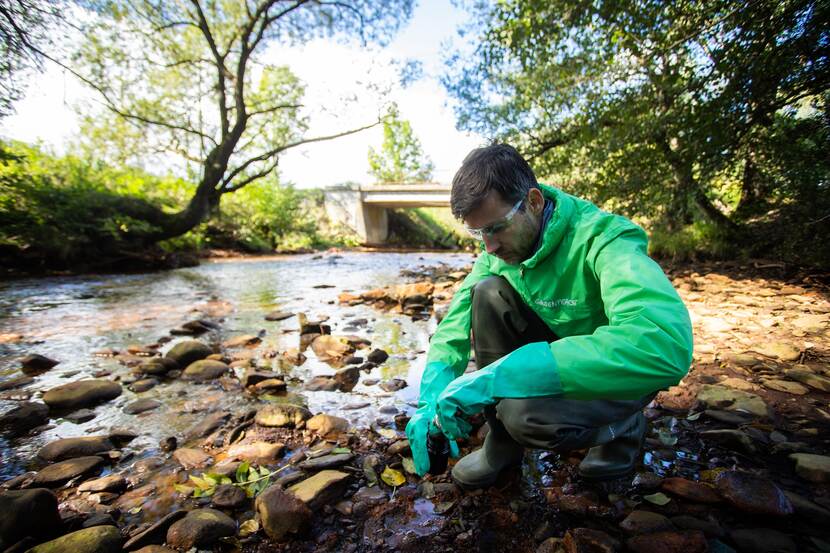Hungary: The story of a polluted river and other news from this week
The effects of arsenic contamination in the River Sajó, animal welfare R&D in the dairy industry, the effect of the firewood boom on the rural poor, and a window of opportunity for sugar beet farming in Hungary - Our weekly briefing on agriculture, food and nature news in Hungary.

Greenpeace finds “significant arsenic pollution” in the River Sajó
We have reported earlier this year that a shut-down plant in an iron mine in Slovakia was leaking industrial waste into the River Sajó, in Slovakia and Hungary.
In October, Greenpeace Hungary has published the results of their latest field tests that the NGO conducted at various points on the both the Slovakian and Hungarian parts of the river. The samples were analyzed by an independent laboratory.
The samples taken from the Slovakian side close to the border contained arsenic six times the legal limit in Hungary. Shortly after the confluence of the Sajó and the Rima/Rimava, just before the Hungarian border, the arsenic content drops to a level a little under the legal limit in Hungary. Samples taken from the sediment of the river are consistent with a hypothesis that the current level of arsenic is leftover pollution from the February contamination event.
According to Gergely Simon, chemistry specialist at Greenpeace Hungary, “due to the inaction of Slovakian and Hungarian authorities, the contamination has spread in the river and toxic metals have reached the lower reaches of the Sajó and newer pollution waves will still reach the Hungarian section of the river.” Mr. Simon is also urging Hungarian authorities to expand their analysis to river sediment. The specialist is also calling on Slovakian authorities to publish their test results so that damage mitigation and environmental restoration could get underway.
Interestingly, the Sajó is a tributary of the River Tisza, a cardinal waterway of the Carpathian Basin and a major tributary of the Danube. The River Tisza is also last remaining habitat of the Tisza Mayfly, one of the last surviving mayfly species of Europe.
Firewood boom will endanger the poorest, reports NGO
Habitat for Humanity has recently published a report on living conditions in Hungary. A marked change is an uptick in the demand for firewood which will endanger the poorest citizens.
Telex.hu also reported on the situation. According to the news portal’s information, the governmental price cap on firewood led to a boom in the demand, which in turn led to shortages.
In Hungary, heating with firewood is typically much more prominent in lower income rural households. In terms of income, in the top fifth of society, heating with firewood is lower than 10%, 49% uses gas heating and 20.5% uses district heating. In the lowest fifth of the income curve however, 17% uses both gas and firewood heating and 41.6% uses only firewood.
Habitat for Humanity also stated in their report that the government’s subsidy on firewood cannot cover the whole country and its appropriation is unjustly divided among various regions. The NGO suggests new governmental programs in order to combat energy poverty among the lowest income households in Hungary.
Dairy R&D: Cattle health diagnostics system being developed by Hungarian company
The company Béke Agrár Kft. together with the Hungarian University of Agriculture and Life Sciences (MATE) is developing a new diagnostics and health monitoring system, reports the agriculture news magazine Magyar Mezőgazdaság.
Deputy Rector in charge of development, Dr. Dávid Mezőszentgyörgyi, has commented that “the genetic limits have been reached in the case of dairy cattle, both in milk production and in feeding.”
Dr. Balázs Gregosits, chief development officer at the company Béke Agrár has stated that their research project follows the “healthy animal, healthy food” principle. The project focuses on creating a lifelong monitoring and diagnostics system for dairy cattle. The system will track animals’ heart rate, identify heart rate issues, monitor stress and body heat, physical activity, body position, will be able to detect sexually active periods and forecast diseases. The participants of the project expect this to also increase the efficiency of artificial insemination.
Sugar beet producers would increase producer prices
Árpád Dorogi, president of the Hungarian Sugar beet Producers Alliance (CTOSZ) stated that Hungary’s dwindling sugar beet production area would start increasing again, should producers be able to “make a fair deal” with the last sugar factory in the country, reports the portal Agrárszektor.hu.
Climate change also hit sugar beet production, and harvest yields decreased to 40 to 50 tons per hectare, while normally this figure would ideally be 70 t/h.
Imported sugar has always been cheaper in the past decade, which led to a slow but steady dwindling of Hungary’s sugar beet production – The total farmland area dedicated to the cultivation of sugar beet decreased from 17.2 thousand hectares five years ago to just 9.6 thousand this year.
However, according to Mr. Dorogi, even imported sugar is expensive now, meanwhile there is a developing shortage of granulated sugar in the country. Hungary currently only produces 60 thousand tons of sugar while the annual consumption is 300 thousand tons. domestic growers would be able to better supply the market and increase their production numbers – Should they be able to get better deals for their produce. According to Mr. Dorogi, domestic farmers were able to sell sugar beet at a producer price of €46.7/ton, while the price has decreased to around €26/ton in the past years, in large part due to the effect imported sugar had on the market.
The sugar factory in Kaposvár has the capacity to process 1 million tons of sugar beet per year, and domestic producers will only be able to supply 433 thousand tons this year.
Photo credit: Greenpeace Hungary